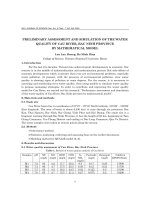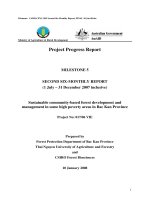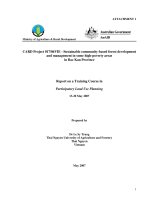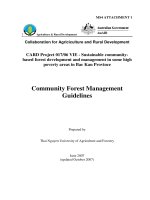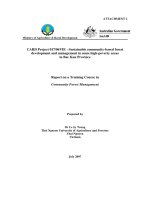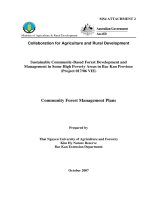179. Ho chicken in bac Ninh province (Vietnam) From an indigenous chicken to local poultry breed
Bạn đang xem bản rút gọn của tài liệu. Xem và tải ngay bản đầy đủ của tài liệu tại đây (403.06 KB, 8 trang )
International Journal of Poultry Science 14 (9): 521-528, 2015
ISSN 1682-8356
© Asian Network for Scientific Information, 2015
Ho Chicken in Bac Ninh Province (Vietnam): From an Indigenous
Chicken to Local Poultry Breed
Nguyen Van Duy1,2, Nassim Moula2, Do Duc Luc1,3, Pham Kim Dang3,
Dao Thi Hiep3, Bui Huu Doan3, Vu Dinh Ton3 and Frederic Farnir2
1
Centre for Interdisciplinary Research on Rural Development,
Vietnam National University of Agriculture, Vietnam
2
Department of Animal Production, Faculty of Veterinary Medicine, University of Liege, Liege 4000, Belgium
3
Faculty of Animal Science, Vietnam National University of Agriculture, Vietnam
Abstract: The objectives of this study were to determine the morpho-biometric characteristics of Vietnamese
indigenous Ho chicken breed and to evaluate its production, reproduction performance and egg quality. The
study was carried out on 20 households raising purebred Ho chicken from September 2013 to April 2015
in Northern Vietnam. Morpho-biometric characterization was based on measurement of 128 adult individuals.
The egg production was observed on 66 hens within 20 households. A total of 29 eggs were freshly collected
from 8 hens at the 20th laying week for quality analysis. Ho chicken breed is a breed with a large dimension,
a large diversity in the colors (black with gold hackle, black copper, wheat, tan and tricolor), a heavy weight
(3.78 and 2.64 for adult males and females, respectively), a low egg production (12.73 eggs/clutch) and a
relatively low rate of embryo eggs (72.81%). A research to improve the egg production and reproduction
should be undertaken to obtain a better performance, economic efficiency while maintaining this genetic
heritage and sustaining the biodiversity of the avian breeds in Vietnam.
Key words: Vietnam, indigenous chicken, biodiversity, productivity, egg quality
More recently, indigenous chicken breeds in Vietnam
have been estimated to amount to 85% of the total
chicken flock (Phan Dang et al., 2009). According to
Moula et al. (2012a,b), the local chicken breeds in
Vietnam include Ri, Te (or Lun, short leg), Tau Vang, Ac
(black meat, white or black feather), Oke, H’mong, Tre,
Choi (fighting chicken), PhuLuuTe, To, Dan Khao (six
toes), Mia, Ho, Dong Tao (thick legs) and Van Phu. With
a reproductive flock of 86.63 to 93.30 million individuals,
the Ri breed was also commonly called “Ga Ta” (native
chicken) accounting for 52 to 56% of total local chicken
herd (Eaton et al., 2006). Under the pressure of the rapid
development of poultry production worldwide (Besbes,
2009), many local chicken breeds have been threatened
with extinction. In Vietnam, the Mia, Ho and Dong Tao
chicken breeds have been reported as endangered or
critical breeds, while the Van Phu chicken breed has
been lost during the last years (Tieu, 2009). However, in
the developing countries like Vietnam, the local chicken
breeds still play as an important tool for the rural
development and poverty fighting. Moreover, any loss of
biodiversity would potentially threaten these countries
ability to meet the future ecological and economic
challenges. In this context and as a first step towards
Vietnamese local breed conservation, this study aims to
determine the morpho-biometric characteristics of the
Ho chicken breed and to evaluate its growth and
INTRODUCTION
Livestock production is an important and promising
agricultural sector in the context of an increasing world
demand for animal products and their high added value
(Delgado et al., 1999). In a global environment with
economic and ecological challenges for sustainable
development, farming practices have been facing
profound changes. In this context, the protection of
biodiversity becomes a vital need, given the numerous
pressures and threats it faces. The poultry production is
no exception to the general phenomenon of genetic
erosion (Besbes, 2009). A rapid spread of intensive
farming practices with hybrid breeds has been led to the
detriment of local chicken breeds, while these continue
playing a central role in rural socio-economic
development in various regions of the world.
In Vietnam, poultry farming is very important. According
to the General Statistics Office of Vietnam (GSO), in
2013, the slaughtered poultry meat production in whole
country accounted for 774.7 thousand tons and was
ranked second after the pork production (GSO, 2014).
Local breeds make up the largest part of the poultry
population, the industrial lines only accounting for a
small percentage. In 2003, in Vietnam, only 20% of the
poultry herd originated from industrial chickens, mainly
obtained by crossbreeding over a total number of 166.6
million chickens (Vang et al., 1999; Eaton et al., 2006).
Corresponding Author: Vu Dinh Ton, Faculty of Animal Science, Vietnam National University of Agriculture, Vietnam
521
Int. J. Poult. Sci., 14 (9): 521-528, 2015
reproductive performance including laying rate and egg
quality. This study plays as the foundation for a
rehabilitation of Vietnamese local chicken breeds, which
is especially suitable with less intensive farming
conditions and that plays a paramount role on socioeconomic and cultural aspects.
omega contents. The quantitative traits were assessed
through measurements of egg weight, yolk weight, shell
weight, albumen weight, yolk diameter, albumen height,
Haugh unit, maximum breakage force, yolk color, egg
length, egg width and shape index. Egg chemical
compositions were dry matter, ash, crude protein and
lipids while amino acids were aspartic acid, serine,
glutamic acid, glycine, histidine, arginine, threomine,
alanine, proline, cysteine, tyrosine, valine as well as
cholesterol and omega 3.
The eggs were weighed using an electronic scale
(accuracy 0.01 g). Lengths and widths were measured
using an electronic sliding caliper (accuracy 0.01 mm).
Egg shape index was calculated by ratio between length
and width. Eggs were broken with careful separation of
yolk and albumen. The shell and yolk were weighed
separately. Albumen weight was determined by
subtracting the yolk and shell weights from the total egg
weight. Yolk and albumen was used for chemical
composition analysis. Chemical compositions were
determined according to standard AOAC methods
(AOAC, 1990) in the laboratories of the Faculty of Animal
Science, Vietnam National University of Agriculture.
Amino acid composition was analyzed using HPLC
method while omega 3 and cholesterol using GCMS
method in National Institute for Food Control, Vietnam.
MATERIALS AND METHODS
This study was carried out on 20 households raising
purebred Ho chicken from September 2013 to April 2015
in Ho town (located 30 km north of Hanoi), Thuan Thanh
district, Bac Ninh province in Northern Vietnam.
Morpho-biometric characterization: Morpho-biometric
characterization was based on measurement of 128
adult individuals (27 males and 101 females over six
months of age). The body sizes were measured
according to FAO standards (FAO, 2012). A mechanical
scale (accuracy ±10 g) was used to weigh the chicken
while a tape measure and an electronic sliding caliper
(accuracy ±0.01 mm) and a tape measure were used for
measuring the body sizes. The collected traits were body
weight and the body sizes (body length, beak length,
comb length, comb height, wattles length, wattles height,
neck length, back length, wing length, thoracic perimeter,
thigh length, tarsus length and tarsus diameter) together
with information about the feather color, tarsus color,
beak color, feathers color and comb type.
Statistical analysis: The data were analyzed using the
general linear model procedure of SAS software (SAS,
1989) to determine the effect of the sex (male and
female) on each morpho-biometric parameter. The
descriptive statistics parameters were mean (Mean),
standard deviation (SD), minimum (Min), maximum
(Max).
Egg production performance: The egg production was
observed on 66 hens of different ages within 20
households. The hens were raised in traditional
conditions inside simple houses to avoid the sun light
and rain and had a small playground for the chickens.
The animals were fed by a mixed ration including paddy
(20.45%), rice (27.97%), rice bran (10.88%), maize
(8.39%), aquatic vegetable (30.36%) and industrial feed
(1.95%). The nutrition components for this mixed ration
were 5.3% crude protein, 2.47% ash, 0.26% calcium,
0.36% phosphorus and 2 483 kcal ME/kg. The eggs
were collected daily and the incubation was made by
hens or turkeys. The production traits were number of
eggs per clutch, number of clutch per year, number of
eggs/hen/year, number of embryonated eggs per clutch,
rate of embryonated egg per clutch, number of chicks
per clutch, rate of chicks born per clutch, number of
chicks born alive per clutch, survival rate of chicks per
clutch and number of chicks per year.
RESULTS
Feather color and aspect: The feather colors and
aspects of Ho chickens are presented in the Table 1. Ho
chickens are characterized by 5 basic feather colors
(2 for males and 3 for females). Two main types of
feather colors were observed for the males, with the
black with gold hackle (Fig. 1a) predominant over the
black copper (Fig. 1b). In parallel, for the females, wheat
(Fig. 2a) and tan color (Fig. 2b) were the most frequently
observed colors, with some hens being tricolor (Fig. 2c).
Yellow red toe (Fig. 3a), Yellow (Fig. 3b) and White red
toe (Fig. 3c) are the three observed types of tarsus color.
The first color is the main color for the males while the
first and third were typical for the females (Table 1).
Three types of combs were found including Walnut (Fig.
4a), Strawberry (Fig. 4b) and Pea (Fig. 4c). While the
dominant type of combs was the walnut (74.07%) for the
males while, the strawberry (48.52%) and the pea
(39.60%) combs were frequently found in the females
(Table 1).
Egg quality: A total of 29 eggs were freshly collected
from 8 hens at the 20th laying week for quality analysis.
Twenty three eggs were used for quantitative traits and
chemical composition analysis of eggs. The six others
were sent to the National Institute for Food Control,
Vietnam for determining amino acid, cholesterol and
522
Int. J. Poult. Sci., 14 (9): 521-528, 2015
(a)
(b)
Fig. 1(a-b): (a) Black with gold hackle feather, (b): Black copper feather
(b)
(a)
(c)
Fig. 2(a-c): (a) Wheat color feather, (b): Tan color feather, (c): Tri color feather
Ho chickens had 2 main beak colors: the dark (Fig. 5a)
and the yellow (Fig. 5b). The frequency of occurrence of
these colors was also different between males and
females. In the males, the two colors occurred with
equal frequencies whereas yellow beaks were observed
in most females (91.09%).
Another sexual dimorphism in Ho chickens can be
observed through the differences in the feather colors of
the ear. Black, Brown, Yellow and White ear feathers
were observed, with the black color present only in the
males, in which it is largely predominant (74.07%) while
Brown (39.80%) and Yellow (57.14%) were found
recently in the females (Table 1).
Morphometric traits: The body weight and body
sizes of Ho chickens are shown in the Table 2. These
values were significantly different between males and
females. The males were heavier than females
(p<0.001) and body sizes were larger (p<0.001) for all
morphometric
parameters.
The
coefficient
of
determination (R2) ranged from 0.7 (for thigh length) to
0.18 (for thoracic perimeter).
523
Int. J. Poult. Sci., 14 (9): 521-528, 2015
(a)
(c)
(b)
Fig. 3(a-c): (a) Yellow red toe, (b): Yellow toe, (c): White red toe
(b)
(a)
(c)
Fig. 4(a-c): (a) Walnut comb, (b): Strawberry comb, (c): Pea comb
(a)
(b)
Fig. 5(a-b): (a) Dark beak, (b): Yellow beak
Egg production performance: The results on the
reproductive performances of Ho chicken are presented
in the Table 3. The egg production of Ho chicken was
low (Table 3). The number of eggs per hen per year
varied largely between hens (min: 28 and max: 126).
This tendency was observed for the other traits. The
embryo eggs per clutch (9.25) and the rate of embryo
eggs (72.81%) were also low for this breed. In average,
a hen could give 41.09 chicks during a year.
The quantitative traits and chemical compositions of Ho
chicken eggs are shown in the Table 4. The quantitative
egg traits were observed from 23 eggs whereas
chemical compositions were from 14 eggs.
The amino acid, cholesterol and omega 3 contents in
the yolk and albumen are shown in the Table 6.
Cholesterol and omega 3 in yolk was significantly higher
than in the albumen (p<0.01). Among 16 amino acids,
the content of 8 acids (aspartic acid, glutamic acid,
524
Int. J. Poult. Sci., 14 (9): 521-528, 2015
Table 1: Physical appearance characteristics of Ho chicken
------------ Male -----------Variable
n
%
Feather color
Black with gold hackle
20
74.07
Black copper
7
25.93
Wheat
Tan
Tricolor
Tarsus color
Yellow, red toe
22
84.48
Yellow
1
3.70
White, red toe
4
14.81
Comb type
Walnut
20
74.07
Strawberry
5
18.52
Pea
2
7.41
Beak colour
Dark horn
14
51.85
Yellow
13
48.15
Feather color of ear
Black
20
74.07
Brown
4
14.82
Yellow
2
7.41
White
1
3.70
---------- Female ---------n
%
------------ Total ----------n
%
55
34
11
55.00
34.00
11.00
20
7
55
34
11
15.75
5.51
43.31
26.77
8.66
48
6
47
47.52
5.94
46.54
70
7
51
54.69
5.47
39.84
12
49
40
11.88
48.52
39.60
32
54
42
25
42.19
32.81
9
82
8.91
91.09
23
105
17.97
82.03
0
39
56
3
0.00
39.80
57.14
3.06
20
43
58
4
16.00
34.40
46.40
3.20
Table 2: Morpho-biometric traits of Ho chicken (Mean±SD)
Variable
Males (n = 27)
Females (n = 101)
Body weigth (kg)
3.78±0.04
2.64±0.07
Body length (cm)
55.25±0.43
46.84±0.25
Beak length (mm)
42.88±0.58
37.73±0.34
Back length (cm)
26.07±0.35
22.45±0.20
Comb length (mm)
38.65±0.76
27.86±0.45
Comb height (mm)
18.63±0.62
8.96±0.39
VBreast length (cm)
21.05±0.22
17.32±0.13
Neck length (cm)
22.33±0.30
19.97±0.17
Tarsus length (cm)
9.78±0.13
7.56±0.07
Tarsus diam 1 (mm)
23.78±0.24
18.62±0.14
Tarsus diam 2 (mm)
19.69±0.29
15.31±0.17
Thigh length (cm)
19.84±0.18
16.03±0.10
Thoracic perimeter (cm)
36.13±0.40
33.30±0.24
Wattles length (mm)
31.15±0.91
22.88±0.65
Wattles height (mm)
27.05±1.27
13.89±0.93
Wing length (cm)
26.94±0.23
22.72±0.13
Diam 1: Diameter at widest part of tarsus, Diam 2: Diameter at thinnest part of tarsus, ***: p<0.001
glycine, alanine, tyrosine, valine, leucine and
phenylalanine) was not significantly different between
albumen and yolk (p>0.05). Cystine and methionine
content in yolk was lower than in albumen (p<0.05).
p-value
***
***
***
***
***
***
***
***
***
***
***
***
***
***
***
***
R2
0.53
0.64
0.26
0.33
0.51
0.58
0.57
0.21
0.57
0.67
0.51
0.70
0.18
0.32
0.38
0.61
without a separating fence, meaning that crosses
between the chicken breeds have not been controlled.
Nevertheless, some breeding objectives have been
pursued. Indeed, this chicken is a traditional product
used in important ceremonies associated with spiritual
life of Vietnamese people (Moula et al., 2012a,b; Lan
Phuong et al., 2015). Cocks with yellow feather colors
are normally chosen for the sacrifice (Luan, 2014). As
could be expected, this study results have shown that
the yellow feather color was dominant in the cock
population. This finding is similar to the research results
of Doan and Luu (2006) and Thuy (2010). The feather
colors in Ho cocks and hens are divided into two
obvious separate groups. In detail, the cocks have the
dark feather color while the hens have the lighter one.
This conclusion was also confirmed by Doan and Luu
(2006).
DISCUSSION
The morphological characteristics of the Ho chicken
show a large feather colors diversity. This result was
also found out in the study of Doan and Luu (2006). The
diversity of the feather colors of Ho chickens suggests
genetic variation in the population of this chicken breed.
Through a long historical period, Ho chickens have been
raised in the household conditions of the rural area in
Vietnam, where many different chicken breeds are
grown in the same region. Accordingly, these individuals
could go freely from a household to other households
525
Int. J. Poult. Sci., 14 (9): 521-528, 2015
Table 3: Reproductive performance of Ho chicken
Variable
Number of eggs per clutch
Number of clutch per year
Number of eggs/hen/year
Number of embryonated eggs per clutch
Rate of embryonated egg per clutch (%)
Number of chicks born per clutch
Rate of chicks born per clutch (%)
Number of chicks born alive per clutch
Survival rate of chicks per clutch (%)
Number of chicks per year
n
66
66
66
65
65
64
64
64
64
64
Mean±SD
12.73±2.16
5.23±0.96
66.18±15.14
9.25±2.37
72.81±11.36
8.03±2.53
63.39±17.05
7.92±2.60
95.68±17.73
41.09±13.75
Table 4: Quantitative traits and chemical composition of Ho chicken eggs
Variable
n
Mean±SD
Egg weight (g)
23
52.49±3.59
Yolk weight (g)
23
16.59±1.76
Egg shell weight (g)
23
5.26±0.56
Albumen weight (g)
23
30.51±2.50
Yolk diameter (mm)
23
42.85±1.55
Albumen height (mm)
23
6.11±1.14
Haugh unit
23
79.28±8.58
Maximum breakage force (N)
23
34.99±6.98
Yolk color (score 1-15)
23
8.09±2.17
Egg length (mm)
23
53.09±1.98
Egg width (mm)
23
41.89±1.26
Shape index (%)
23
79.01±3.75
Dry matter (%)
14
30.15±2.07
Ash (%)
14
1.85±0.41
Crude protein (%)
14
13.03±0.096
Lipid (%)
14
11.44±2.25
In the Red River Delta of northern Vietnam, the hens are
rarely used in the traditional ceremonies. The hens are
mainly raised by the farmers to produce the eggs and
chicks. The farmers tend to choose the hens with lighter
feather colors because they think these chickens will
have a higher reproductive performance. The present
research also
showed that chickens with the light
feather colors were predominant in the hen population.
Keambou et al. (2007) noted that the local tropical hens
have feathers allowing them to have a better ability to
adapt to the weather conditions in their territories.
Leg colors of Ho chickens were rather diverse, with the
chickens having yellow shank, red phalanx slots, hock
and leg edge being predominant in both cocks and hens
populations. In the Ho chicken population, the yellow leg
occurred with a low percentage in cocks (3.70%) and
hens (5.94%). According to the elder farmers who have
a profound knowledge of Ho chickens, the ancient
purebred chickens had yellow legs without mixture with
the other colors. However, farmers wanted to improve
the legs size to follow the consumer demand. Therefore,
Dong Tao chickens (one local chicken breed) were used
to cross with Ho chickens in order to produce hybrids
with big legs. The current mixed color could relate to the
hybridization of Ho chicken population. Additionally, legs
play also an important role in the traditional ceremonies
such as for national New Year and wedding events
(Luan, 2014). Besides that, many Vietnamese people
Min
7
4
28
5
46.15
0
0
0
0
0
Min
44.60
12.40
3.90
27.10
39.61
3.80
58.70
15.87
4
48.83
40.16
73.89
24.04
1.01
11.49
6.82
Max
19
7
126
17
93.75
13
92.31
13
100
70
Max
59.50
18.70
6.20
35.10
45.10
8.00
92.60
47.74
11
56.01
44.37
87.72
32.47
2.44
14.28
14.00
prefer chicken legs as eating hobby. Chicken legs are
easily found in the traditional restaurants today.
For the cocks selected for the sacrifice, the comb is an
important selection criterion. The local people often
choose chickens with bright red combs as the ripe
strawberry color and the comb has to be tidy to avoid the
situation that the comb be fallen to one side after boiling,
because, according to the local people, when the comb
is fallen, it means that their business will not be
favorable. The comb type of Ho chicken over the years
have also been selected according to the farmers
orientation, so all three comb types of Ho chickens have
tidy shapes, with the walnut comb type accounting for a
predominant percentage in the cocks population while
the strawberry comb is in the majority in the hens
population.
With a long history under the pressures of natural and
artificial selection processes, Ho chicken has adapted
well to the local conditions in the Red River Delta,
Northern Vietnam. The direct observation and
description of the phenotype of Ho chicken is an
important work to provide information for the research
targeting the exploitation of the breed and its sustainable
conservation. The phenotypic diversity in the existing Ho
chickens population reveals the introduction of exotic
genes resources into the pure Ho chicken population.
This is a threat introducing concerns for the genetic
resource erosion of the Ho chicken herd. However,
526
Int. J. Poult. Sci., 14 (9): 521-528, 2015
Table 5: Amino acid and cholesterol composition in eggs of Ho chicken (Mean±SD)
Variable
Albumen (n = 6)
Yolk (n = 6)
Cholesterol (mg/100 g)
18.78±4.12
309.50±58.31
Omega 3 (mg/100 g)
0.18±0.22
48.33±22.56
Aspartic acid (mg/g)
8.39±1.40
9.78±0.83
Serine (mg/g)
3.50±0.76
4.82±1.19
Glutamic acid (mg/g)
11.17±1.85
12.96±1.30
Glycine (mg/g)
2.23±0.39
2.45±0.18
Histidine (mg/g)
2.25±0.49
2.79±0.18
Arginine (mg/g)
4.39±0.74
5.80±0.90
Threomine (mg/g)
2.94±0.56
4.07±0.57
Alanine (mg/g)
4.70±0.79
5.01±0.40
Proline (mg/g)
2.79±0.46
3.96±0.41
Cystine (mg/g)
0.71±0.15
0.48±0.09
Tyrosine (mg/g)
2.52±0.53
2.29±0.98
Valine (mg/g)
5.96±0.98
6.67±0.63
Methionine (mg/g)
2.98±0.52
2.41±0.24
Lysine (mg/g)
5.52±0.88
7.68±1.28
Isoleucine (mg/g)
4.31±0.69
5.49±0.60
Leucine (mg/g)
6.42±1.03
8.07±1.50
Phenylalanine (mg/g)
4.72±0.82
4.44±0.33
*: p<0.05, **: p<0.001, ***: p<0.0001, NS: p>0.05
these hybridizations also provide the opportunity to
create new and better individuals, fitted to the nowadays
conditions while preserving the main characteristics of
the original breed.
Ho chicken is one of the local breeds in Vietnam with a
heavy weight. The body weight of adult cocks and hens
were 3.78 and 2.64 kg on average, respectively. These
results are similar to previous researches (Doan and
Luu, 2006; Thuy, 2010; Moula et al., 2012a,b).
According to Cuc (2010), the weights of adult Ho
chickens are among the largest, with Dong Tao (3.5-4.5
kg) and Choi (3.5-5 kg). Along with the large weight, the
body sizes of Ho chickens such as the body length, wing
length, leg length and neck length were also particularly
large.
Being used in ceremonial activities, the Ho cock is also
drawn on folk drawings on a special paper type and
hung solemnly in the living room inside the houses in
the Red River delta. Ho chickens are presented in a
traditional festival organized in the early spring in Ho
town, Bac Ninh province to select beautiful and
representative chickens. That is one of the reasons for
the farmers to often select Ho chickens with long legs,
long neck and large body shape for raising. As
mentioned above, the average neck lengths of the cocks
and the hens were 22.33 and 19.97 cm, respectively
while the average body length of the cocks and the hens
were 42.88 and 37.73 cm, respectively. For comparison,
the average neck lengths of Ri chickens were from 17.85
to 19.18 cm (cock) and from 14.66 to 15.26 cm (hen); the
average body lengths were from 36.65 cm to 38.85 cm
(cock) and from 30.54 to 32.96 cm (hen) (Moula et al.,
2012a,b).
In the present study, the eggs production varied largely
between hens. This result indicated that selection tools
were not applied in the household system. The average
p-value
***
**
NS
*
NS
NS
*
**
**
NS
***
***
NS
NS
*
**
**
NS
NS
R2
0.09
0.68
0.30
0.43
0.27
0.14
0.39
0.47
0.55
0.07
0.68
0.50
0.02
0.18
0.38
0.54
0.50
0.33
0.05
egg production of Ho chickens is similar to the study of
Doan and Luu (2006). The average egg production for
one clutch was low. The low laying performances of
local chicken breeds have been confirmed in many
related studies (Moula et al., 2012a,b), with the Ho breed
ranking among the worst in terms of eggs production by
hen by year (Cuc, 2010).
When finishing each clutch, the eggs move to the
hatching period. In Ho town, local people still use hens
or turkeys as incubation. Many farmers used turkeys for
hatching instead of Ho hens. According to the farmers,
Ho hens have a heavy weight so it is difficult for them to
move into the clutch, or to manipulate the eggs, which
leads to a high risk of breaking the eggs. The Ho hen
were considered bad broody because she do not have
many feathers to maintain heat. Each year, the number
of laying cycle of Ho chicken is low. The rate of eggs
leading to an embryo was low. This might due to the
heavy cock weights, leading to mating difficulties. The
egg weight of Ho chickens was higher than those of
other local chicken breeds such as Dong Tao (48.5 g),
H'Mong (42.5 g) and Te chicken (41.62 g) (Lung et al.,
2004; Thieu et al., 2004a,b). This tendency was also
observed for the weight of the yolk (Lung et al., 2004;
Thieu et al., 2004a,b). The Haugh unit of Ho egg is lower
than the egg of H’Mong chicken, Te chicken (Lung et al.,
2004; Thieu et al., 2004a,b). The amino acid contents in
the yolk of Ho were lower in comparison with previous
researches (My et al., 2010; Genchev, 2012). The feeds
using in the different systems might affect the eggs
quality.
Conclusion: The Ho is a chicken breed with a large
dimension, a large diversity in the colors, a heavy weight,
a low egg production and reproduction. A research to
improve the egg production and reproduction should be
527
Int. J. Poult. Sci., 14 (9): 521-528, 2015
undertaken to obtain a better economic efficiency while
maintaining this genetic heritage and sustaining the
biodiversity of the avian breeds in Vietnam.
Luan, L.D., 2014. Aspects of the vietnamese traditional
culture through a proverb. Language and Life, 3: 3638.
Lung, B.D., V.T. Hung and D.L. Luong, 2004. Report
keeping gene bank of dong tao chicken. In:
Workshop conservation of livestock gene fund
1990-2004. National Institute of Animal Sciences,
Hanoi, Vietnam, pp: 107-122.
Moula, N., N. Antoine-Moussiaux, L. Do Duc, D. Pham
Kim, T. Vu Dinh, B. Dang Vu, P. Leroy and F. Farnir,
2012a. Comparaison de la qualite des œufs de
deux races de poules vietnamiennes (ri et mia). In:
10eme Journeses des Sciences Veterinaires.
Moula, N., P.K. Dang, F. Farnir, V.D. Ton, D.V. Binh, P.
Leroy and N. Antoine-Moussiaux, 2012b. The ri
chicken breed and livelihoods in north vietnam:
Characterization and prospects. J. Agric. and Rural
Dev. in the Tropics and Subtropics, 112: 57-69.
My, H.N., T.N.A. Tuan and N.X. Duy, 2010. Chemical
composition and amino acid content of chicken egg
white. J. Sci. and Dev., 4: 693-697.
Phan Dang, T., M. Peyre, T. Vu Dinh, F. Roger, J.F.
Renard and S. Desvaux, 2009. Characteristics of
poultry production systems and cost-benefit
analysis of mass vaccination campaign against
hpai in poultry production systems in long an
province, south vietnam. J. Sci. Dev., 7(English. Iss.
1).
SAS, 1989. Sas/stat. User’s guide, version 6, 4th edition.
Cary, NC: SAS Institute.
Thieu, P.C., VV. Su, H.V. Tieu and L.T. Thi Hong, 2004a.
Report biological characteristics and production
capabilities of chicken te. In: Workshop
conservation of livestock gene fund 1990-2004.
National Institute of Animal Science, Hanoi,
Vietnam, pp: 133-144.
Thieu, P.C., V.V. Su and H.L. Son, 2004b. Conserve,
selective and develop of h'mong chicken. In:
Workshop conservation of livestock gene fund
1990-2004. Nationall Institure of Animal Science
Hanoi, Vietnam, pp: 145-152.
Thuy, L.T., 2010. Determine the genetic variation of local
breeds. Natl. Inst. of Anim. Sci., Hanoi, Vietnam, pp:
105.
Tieu, H.V., 2009. Conservation and exploitation of animal
genetic resources in vietnam. Natl. Inst. of Anim.
Sci. Hanoi, Vietnam, pp: 15-20.
Vang, N.D., T.C. Xuan, P.D. Tien, L.T. Nga and N.M.
Hung, 1999. Possibility of mia chicken production in
farming thuy phuong. Magazine Poult., 8: 35-39.
ACKNOWLEDGEMENTS
This research was supported by Ministry of Education
and Training and Ministry of Agriculture and Rural
Development, code: 16/2012/HD-HTQTSP.
REFERENCES
AOAC, 1990. Official methods of analysis. 15th edition
Edn., Arlington, VA: Association of Official Analytical
Chemists.
Besbes, B., 2009. Genotype evaluation and breeding of
poultry for performance under sub-optimal village
conditions. World’s Poult. Sci. J., 65: 260-271.
Cuc, N.T.K., 2010. Vietnamese local chicken breeds:
Genetic diversity and prioritizing breeds for
conservation. Georg-August Universitat, Gottingen,
Germany, pp: 118.
Doan, B.H. and N.V. Luu, 2006. A survey on distribution,
conformation, growth and productivity of ho chicken.
J. Sci. and Dev., 4: 95-99.
Delgado, C., M. Rosegrant, H. Steinfeld, S. Ehui and C.
Courbois, 1999. Livestock to 2020 the next food
revolution. Discussion paper. A 2020 Vision for
Food, Agriculture and the Environment 28,
International Food Policy Research Institute,
/>vb61.pdf, (23/12/2014).
Eaton, D., J. Windig, S. Hiemstra, M. van Veller, N. Trach,
P. Hao, B. Doan and R. Hu, 2006. Indicators for
livestock and crop biodiversity. Centre for Genetic
Resource, the Netherlands, CGN/DLO Foundation,
Wageningen, pp: 22-24.
FAO, 2012. Phenotypic characterization of animal
genetic resources, fao anial production and health.
Rome: Food and agriculture organization of united
nations.
Genchev, A., 2012. Quality and composition of
japannese eggs (coturnix japonica). Trakia J. Sci.,
10: 91-101.
GSO, 2014. Statistical handbook of viet nam. General
statistic office: Statistical Publishing House.
Keambou, T., Y. Manjeli, J. Tchoumboue, A. Teguia and
R. Iroume, 2007. Caracterisation morphobiometrique des ressources genetiques de poules
locales des hautes terres de l’ouest cameroun.
Livest. Res. Rural Dev., 19.
Lan Phuong, T.N., K.D.T. Dong Xuan and I. Szalay, 2015.
Traditions and local use of native vietnamese
chicken breeds in sustainable rural farming.
World's Poult. Sci. J., 71: 385-396.
528
View publication stats


